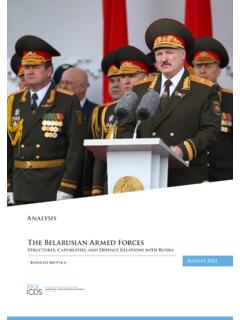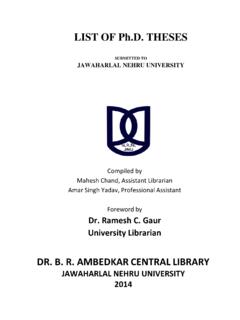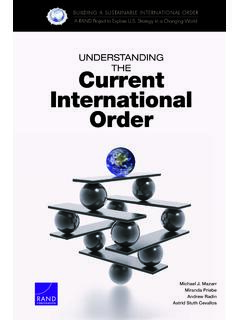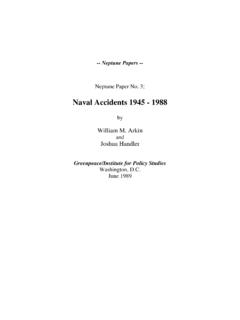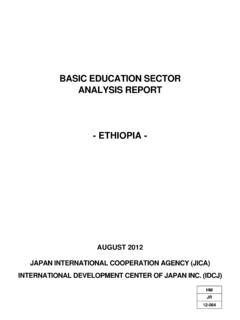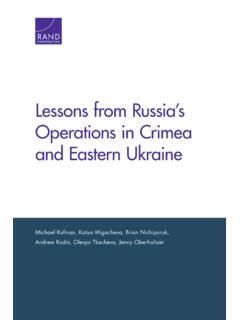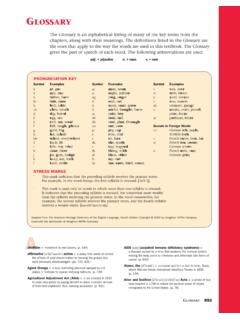Transcription of Russia's Electronic Warfare Capabilities to 2025 - ICDS
1 REPORT. Russia's Electronic Warfare Capabilities to 2025. Challenging NATO in the Electromagnetic Spectrum September 2017. Roger N. McDermott with a foreword by Gener al Michael Hayden Title: Russia's Electronic Warfare Capabilities to 2025: Challenging NATO in the Electromagnetic Spectrum Author: McDermott, Roger N. Project director: Jermalavi ius, Tomas Publication date: September 2017. Category: Report Keywords: Anti-Access/Area Denial (A2/AD), Capabilities & Capability Planning, Command &. Control, Electronic Warfare , Defence Acquisition, Defence Industry, NATO, Russia, Ukraine, Syria, Georgia Photos: Cover page Russian soldiers erect an antenna of a Krasukha-4 EW complex. Page VII Control panel of a Krasukha-4 EW complex.
2 Page 31 Inside an antenna section of a Krasukha-4 EW complex. Source: Voyennoye Obozreniye ( military Review ), Disclaimer: This report was supported by a research grant provided by the Estonian Ministry of Defence. The views and opinions contained in this report are those of its author only and do not necessarily represent the official policy or position of the International Centre for Defence and Security or Estonian Ministry of Defence. ISSN 2228-0529. ISBN 978-9949-9885-9-4 (print). 978-9949-9972-0-6 (PDF). International Centre for Defence and Security 63/4 Narva Rd., 10152 Tallinn, Estonia Russia's Electronic Warfare I. Foreword When the Russian army stormed into Georgia in August 2008, we lacked detailed knowledge of its Capabilities .
3 Our technical systems were even challenged to locate the limits of the Russian advance. In 2014 the Russians, their little green men and their concept of hybrid war surprised us again with the rapid seizure of Crimea and the occupation of part of the Donbas region in Ukraine. This same Russian army is today in a position to threaten the Baltic states and NATO's entire eastern flank. The time for surprises should be over. Thankfully, the International Centre for Defence and Security in Estonia has created a detailed, fact- based study on one critical aspect of Russia's growing Capabilities : Electronic Warfare (EW). Moscow relies on and has heavily invested in EW as an asymmetrical response to NATO's technological edge across the spectrum of conflict and as an integral part of its anti-access/area denial strategy.
4 If Moscow can negate NATO's command, control and intelligence systems, it will make the Alliance's defence of its new members problematic and costly. Thus, ICDS's study could not be more timely. This is a professional work that catalogues the seriousness of the threat without being unduly alarmist. It is fact based, from the detailed descriptions of Russian equipment and investment; through Moscow's development of organisation and command structure; to accounts of training, tactics and operations. There is also a great discussion of Russian doctrine and how Russian EW fits into broader questions of cyber and psychological operations and how that convergence will further challenge NATO's concepts and practices.
5 I highly recommend this important work as the departure point for the Alliance rethinking and reshaping its response to a growing danger. General (retired) Michael HAYDEN. Former Director of the US National Security Agency (NSA). and Central Intelligence Agency (CIA). Russia's Electronic Warfare II. Acknowledgments The author wishes to express his grateful appreciation to the staff and leadership of the ICDS and Estonian Ministry of Defence for making this study possible, and to the interviewed experts for sharing their knowledge and offering candid and insightful comments. About the Author Roger joined the International Centre for Defence and Security in April 2016 as a Non-Resident Research Fellow. He is a Senior Fellow in Eurasian military Studies, The Jamestown Foundation, Washington DC, Senior International Research Fellow for the Foreign military Studies Office (FMSO), Fort Leavenworth, Kansas, USA, and Research Associate, the Institute of Middle East, Central Asia and Caucasus Studies (MECACS), University of St.
6 Andrews, Scotland, UK. Roger N. McDermott is on the editorial boards of Russian Law & Politics, Central Asia and the Caucasus and the scientific board of the Journal of Power Institutions in Post- soviet Societies. His weekly assessments of military , security and strategic developments in Russia and Central Asia appear in Eurasia Daily Monitor, the flagship publication of The Jamestown Foundation. Roger N. McDermott specialises in Russian and Central Asian defence and security issues. His interests in Russia's defence and security developments are mainly in the areas of defence reform, force structure, training, strategic exercises, military theory, perspectives on future Warfare , planning and combat capability and readiness, as well as operational analysis.
7 Among his numerous publications are the following: Brothers Disunited: Russia's Use of military Power in Ukraine, (Eds., Black and Michael Johns), Return of the Cold War. Ukraine, the West, and Russia, Routledge: London, 2016; (Editor) The Transformation of Russia's Armed Forces: Twenty Lost Years, London: Routledge, 2014, and co-editor with Bertil Nygren and Carolina Vendil-Pallin, The Russian Armed Forces in Transition: Economic, Geopolitical and Institutional Uncertainties, Routledge: London, 2011. His latest report, co-authored with Tor Bukkvoll, is Russia in the Precision-Strike Regime: military Theory, Procurement, and Operational Impact, FFI, 2017. Russia's Electronic Warfare III. Executive Summary Russia's Armed Forces' Electronic Warfare (EW) capability development will pose a serious challenge to the proper planning and execution of NATO's defence of the Baltic states, and NATO's entire Eastern Flank, in the event of a Russian assault.
8 This capability is an integral part of Russia's anti-access/area denial (A2/AD) approach and is clearly tailored to target NATO's C4 ISR. Russia's growing technological advances in EW will allow its forces to jam, disrupt and interfere with NATO communications, radar and other sensor systems, Unmanned Aerial Vehicles (UAVs). and other assets, thus negating advantages conferred on the Alliance by its technological edge. Be it in the air, maritime, land or cyber domains, NATO will encounter an increasingly capable adversary focused on developing and deploying a vast array of EW systems as force enablers and multipliers . Many of those systems are being introduced in units across all services stationed in Western military District (MD) adjacent to NATO's borders.
9 Moscow's interest in boosting EW Capabilities vis- -vis NATO has its origins in seeking to asymmetrically challenge the Alliance on Russia's periphery and maximise its chances of success in any operation against NATO's eastern members. Russia has consistently invested in EW modernisation since 2009, with modernised EW systems entering service across strategic, operational and tactical levels to augment Capabilities of all service branches and arms. Modernisation of the EW inventory is set to continue in the State Armaments Programme up to 2025, which means Russia's military will benefit greatly from further advances in EW capability. Moscow is stepping up its efforts to renew and modernise the EW inventory, and this effort is complemented by changes to organisation, doctrine, command structure, training and tactics, as well as techniques and procedures.
10 The effect of those changes is evident in Russia's aggression against Ukraine, where EW forms an organic part of Russia's kinetic and non-kinetic operations both in support of proxy forces and conducted independently. Russia is actively developing a total package of EW systems to include a broad frequency range and other systems; these seem advanced and capable. In addition to such systems covering surveillance, protection and countermeasures (jamming), they cover measures to protect Russia's own usage of the electromagnetic spectrum (EMS). These systems also offer countermeasures against Western civilian and military usage of the EMS. Many of these Russian EW systems are highly mobile, including small systems deployable by UAVs, making targeting and neutralising them more complex and challenging.
